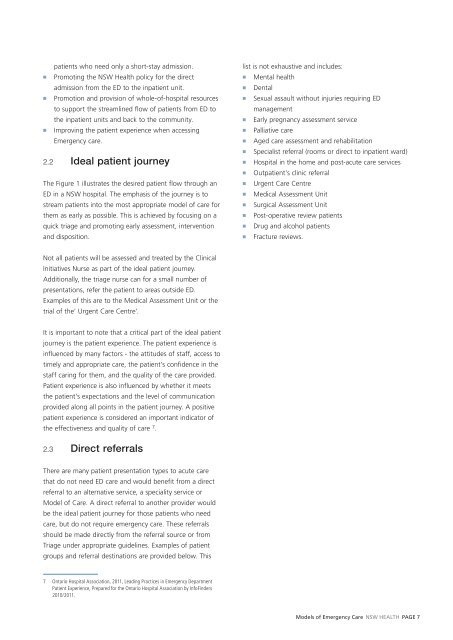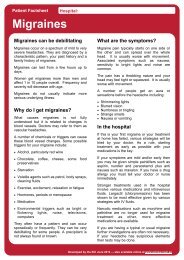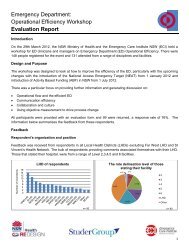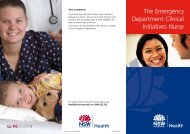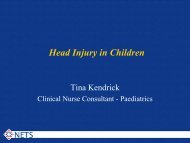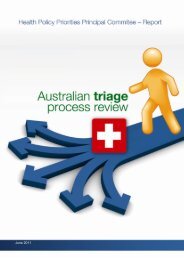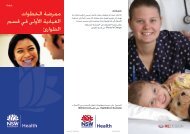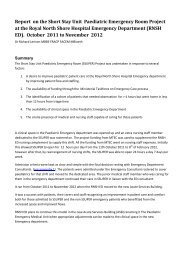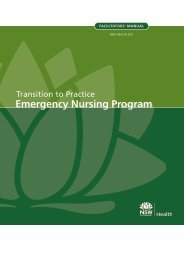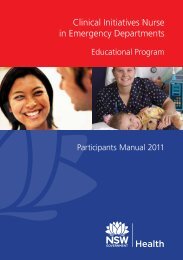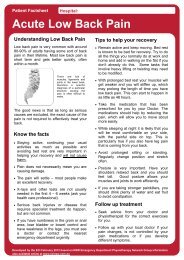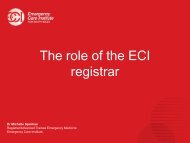Emergency Department Models of Care 2012 - NSW Health
Emergency Department Models of Care 2012 - NSW Health
Emergency Department Models of Care 2012 - NSW Health
- No tags were found...
Create successful ePaper yourself
Turn your PDF publications into a flip-book with our unique Google optimized e-Paper software.
■■■patients who need only a short-stay admission.Promoting the <strong>NSW</strong> <strong>Health</strong> policy for the directadmission from the ED to the inpatient unit.Promotion and provision <strong>of</strong> whole-<strong>of</strong>-hospital resourcesto support the streamlined flow <strong>of</strong> patients from ED tothe inpatient units and back to the community.Improving the patient experience when accessing<strong>Emergency</strong> care.2.2 Ideal patient journeyThe Figure 1 illustrates the desired patient flow through anED in a <strong>NSW</strong> hospital. The emphasis <strong>of</strong> the journey is tostream patients into the most appropriate model <strong>of</strong> care forthem as early as possible. This is achieved by focusing on aquick triage and promoting early assessment, interventionand disposition.list is not exhaustive and includes:■■■■■■■■■■■■■■■Mental healthDentalSexual assault without injuries requiring EDmanagementEarly pregnancy assessment servicePalliative careAged care assessment and rehabilitationSpecialist referral (rooms or direct to inpatient ward)Hospital in the home and post-acute care servicesOutpatient’s clinic referralUrgent <strong>Care</strong> CentreMedical Assessment UnitSurgical Assessment UnitPost-operative review patientsDrug and alcohol patientsFracture reviews.Not all patients will be assessed and treated by the ClinicalInitiatives Nurse as part <strong>of</strong> the ideal patient journey.Additionally, the triage nurse can for a small number <strong>of</strong>presentations, refer the patient to areas outside ED.Examples <strong>of</strong> this are to the Medical Assessment Unit or thetrial <strong>of</strong> the’ Urgent <strong>Care</strong> Centre’.It is important to note that a critical part <strong>of</strong> the ideal patientjourney is the patient experience. The patient experience isinfluenced by many factors - the attitudes <strong>of</strong> staff, access totimely and appropriate care, the patient’s confidence in thestaff caring for them, and the quality <strong>of</strong> the care provided.Patient experience is also influenced by whether it meetsthe patient’s expectations and the level <strong>of</strong> communicationprovided along all points in the patient journey. A positivepatient experience is considered an important indicator <strong>of</strong>the effectiveness and quality <strong>of</strong> care 7 .2.3 Direct referralsThere are many patient presentation types to acute carethat do not need ED care and would benefit from a directreferral to an alternative service, a speciality service orModel <strong>of</strong> <strong>Care</strong>. A direct referral to another provider wouldbe the ideal patient journey for those patients who needcare, but do not require emergency care. These referralsshould be made directly from the referral source or fromTriage under appropriate guidelines. Examples <strong>of</strong> patientgroups and referral destinations are provided below. This7 Ontario Hospital Association, 2011, Leading Practices in <strong>Emergency</strong> <strong>Department</strong>Patient Experience, Prepared for the Ontario Hospital Association by InfoFinders2010/2011.<strong>Models</strong> <strong>of</strong> <strong>Emergency</strong> <strong>Care</strong> <strong>NSW</strong> HEALTH PAGE 7


